THE WEATHER WON’T PUSH ME AROUND
/5 Comments/in Fruit, Gardening, Planning, Pruning, Vegetables/by Lee ReichBreaking (Pruning) Rules
Snow squall or not, I just had to get outside. Not enough snow for a cross-country ski, but, after too much time indoors, I had to do something outside.
I was driven to break a fundamental rule of the garden. I pruned, and that’s a no-no. Pruning is best delayed until at least after the coldest part of winter is over, ideally closer to the time when warmth and sun are stirring buds to swell in preparation for their final burst. I did rationalize that any pruning now would leave me that much less to do amidst the hubbub of spring gardening activities.
I wasn’t indiscriminate in trespassing this Rule of Gardening. The plants that I pruned were gooseberries, which are very cold-hardy plants so are unlikely to suffer any cold damage as a result of untimely pruning. Also, no need to wait, as is done with peaches, for growth to begin to see which branches have died back from winter cold; none ever do so on a gooseberry bush.
Pruning without spring breathing down my back made for a very relaxed pruning session. I had plenty of time to pay attention to details and prune a little differently than in the past.
Gooseberries bear fruits on stems that are 1-, 2-, and 3-years-old, so the usual method of pruning is to cut away any stems more than 3-years-old and remove all but six of the sturdiest 1-year-old stems. The pruned bush, then, is left with a half-dozen each of 1-, 2-, and 3-year old stems. Each year a bush is renewed as oldest stems are removed, and new grow kept vigorous and healthy as excess young stems are thinned out.
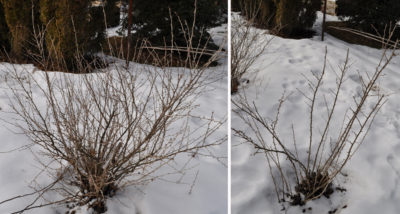
Gooseberry before & after pruning
The gooseberry bushes always bear many more berries than we can eat, and their weight bows the branches to the ground. So this year I decided to also prune each side branch on the older stems back to a couple of inches long. I’ll reap fewer berries, but those that remain should be larger and more accessible among the thorny stems.
Great Gooseberries
Is it worth mentioning such details about growing gooseberries? After all, who eats gooseberries these days? To most people, a gooseberry is a small, green, tart berry suitable only for pies, jams, and fools (a dessert made by folding cooked, sweetened, sieved gooseberries into whipped cream).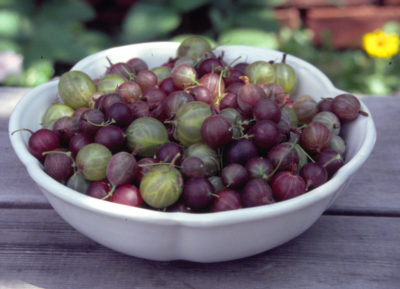
If small, green, and tart is your idea of a gooseberry, you’ve never tasted a so-called dessert gooseberry. Dessert gooseberries are sweet and flavorful right off the bush; they are, as Edward Bunyard wrote almost a hundred years ago in The Anatomy of Dessert, “the fruit par excellence for ambulant consumption.” (He was from England, where gooseberries are more appreciated and known than here.)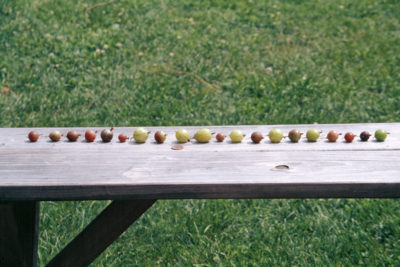
Only certain gooseberry varieties warrant the label “dessert gooseberry,’ of which I grow about a dozen varieties. My favorites include Hinonmakis Yellow, Poorman, Black Satin, Webster, Red jacket, and Captivator. Their sweet flavors carry wine-y overtones and reminiscences of plum or apricot. Some have soft skins, others have firm skins that explode with the flavorful, sweet juice when you bite into them. I devote a whole chapter to the history and varieties of gooseberries as well as how to grow them and where to get them in my book Uncommon Fruits for Every Garden (available from the usual sources and, from me and signed, at my website).
Back Indoors, But Still Gardening
Frozen fingertips eventually drove me back indoors. But I’m now on a gardening roll, spurred on further by a box of seed packets that arrived in the mail.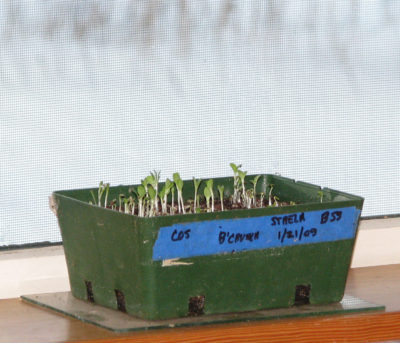
Lettuce, claytonia, and celery from the greenhouse have been filling our salad bowls all winter. As these plants wane or go to seed, we’ll need more. So today I sowed seeds of Black-Seeded Simpson, Romaine, Buttercrunch, Blushed Butter Cos, and Majestic Red lettuces. Some I sprinkled into seed flats that can be kept warm for quick germination. Some I sowed right in the ground beds in the greenhouse; they’ll germinate more slowly but hold their quality longer than those that are pricked out from seed flats into “cells” and then into the garden.
Sometime soon, I’ll grab my pruning shears and get back to the gooseberries. And then on to the grapes, the kiwis, the apples, the pears, the . . .
IN WITH THE NEW, STILL WITH THE OLD
/7 Comments/in Fruit, Gardening, Houseplants, Pests, Planning, Vegetables/by Lee ReichScale Attack Beginning!
As if to ring in the new year, scale insects are starting to make their presence known. These insects crawl around as babies, find nourishing spots on leaves or stems, insert their feeding tubes, and then spend their days sucking plant juice. Carbohydrates and sugars are what result when sunlight and chlorophyll get together, so longer days may already be making plant sap sweeter and more plentiful, much to the liking of these suckers.
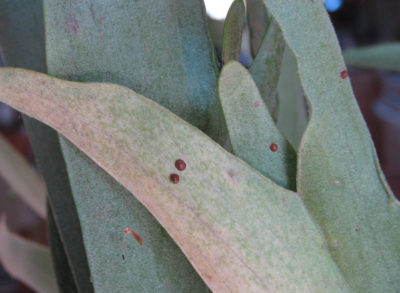
Armored scale on staghorn fern
I encounter two kinds of scales on my houseplants. Each armored scale looks like a small, raised, brown tab. Cottony cushion scale looks like a small tuft of white cotton. As either kind feeds, it exudes a sweet honeydew that drips on leaves, furniture, and floor, and eventually becomes colonized with a fungus that airbrushes those sticky drippings an unappealing smokey haze.
(Scale insects are often problems on trees and shrubs outdoors. I’ve never had any problems outdoors probably because natural predators, of which scale insects have many, can do their job. Once indoors in autumn, houseplants lose the benefits of these natural, outdoor predators. )
Repeated sprays last autumn of “horticultural” oil smothered the creeping, crawling baby scales as they were looking for homes on houseplants. I do all this spraying outdoors, where it is most convenient, before the plants come indoors for winter. None have turned up yet on the kumquat or the staghorn fern, both of which have been scale magnets in the past. I don’t see any on the bay laurel, another magnet, but I do see and feel the tell-tale sticky honeydew.
And . . . Counterattack
Cute, little white tufts of cottony cushion scale are starting to dot the undersides of strawberry guava’s leaves. It’s not surprising: I received this plant last autumn, already with scale, and it was too late then to start spraying with oil. As autumn progressed, the undersides of its leaves became increasingly covered with those white tufts.
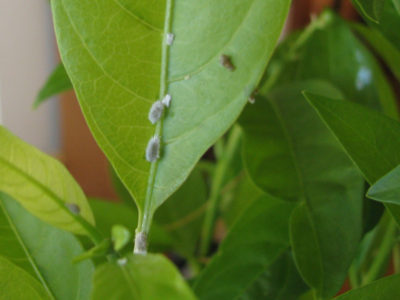
Cottony cushion scale
Repeatedly, over the last few months, I have fought back the buggers mano a mano by dipping cotton swabs in alcohol and methodically cleaning them off each leaf. (The plant is young and its leaves are large and few.) The last cleaning was especially thorough but some eggs evidently survived. Time to get out the alcohol and swabs again.
Mmmm, Tomatoes, In Planning Stage
Like the scale insects, I feel the distant tug of spring and spring seed orders are complete. With most vegetables and flowers, I’m pretty picky about variety so have to rely on mail order sources for my seeds.
And especially so with tomatoes: I refuse to waste time and space growing anything but the best tomatoes (to me), which makes me very wary of trying new varieties. My own tried and true varieties — flavor is what I’m after — include Belgian Giant, Sungold, Anna Russian, San Marzano, Amish Paste, Rose de Berne, Nepal, Valencia, Cherokee Purple, and Blue Beech.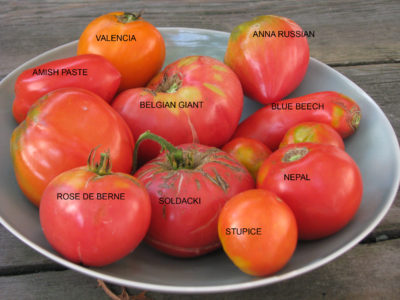
Every once in a while I’ll also grow a few others, but only if they come highly recommended from a reliable source and especially if they are an “oxheart” or “black” fruited variety. Not even worthy of consideration is any “determinate” variety because their leaf to fruit ratio is too low for good-tasting fruit. The seed catalog or seed packet itself should say whether a variety is determinate or indeterminate. This year’s tomato newbies include Rosella Purple and Dwarf Sweet Sue, both recommended by a reader of this column.
I highly recommend growing tomatoes from seed. It’s easy, especially if the seeds are sown in a timely manner, which is about 6 weeks before the average date of the last killing frost of spring — about April 1st here in USDA Hardiness Zone 5.
Onions, Last Year And This Year
It’s really not all that early to be ordering seeds. My date for sowing onion and leek seeds is February 1st. New York Early, Copra, Sweet Spanish, and Ailsa Craig are three onion varieties that did well for me last season, and will be returning for an encore. Last summer’s onions still hang in braids from the basement rafters, ready to be pulled off as needed to chop into a pan for roasting with sweet potatoes, into the soup pot with chickpeas and kale, and other savory dishes for weeks to come. 
EVERYTHING’S EASY, FOR NOW
/2 Comments/in Flowers, Gardening, Houseplants, Planning, Vegetables/by Lee ReichAn Easy Orchid
Orchids are one group of plants I’ve regularly sidestepped. It seemed to me that if you grew orchids, you became crazed over orchids, to the exclusion of other plants. You then fill your home with as many of the over 20,000 species as you can cram onto your windowsills. I feared being led down that path.
My sidestepping took a turn into orchid-land 25 years ago when a local orchid enthusiast gave me a plant of Odontoglossum pulchellum, which I today learned has also been called lily-of-the-valley orchid. But more importantly today, the plant is in bloom. Blossoms from this plant are no rare occurrence; it’s bloomed every year for about the past 20 years, some years around now and other years waiting until February to unfold.
Odontoglossum pulchellum doesn’t sport knock-your-socks-off, traffic-stopping blossoms; instead, they have a soft, subtle beauty. Right now, delicate, arching flower stems rise up from clusters of torpedo-shaped, green pseudobulbs that are perched up out of the “soil.” Eight to 10 dainty, waxy, white blossoms line up along each flowering stem and waft a sweet fragrance, more like paper-whites than lily-of-the-valley to me, that transports me to spring.
I get all this for very little effort and without becoming orchid-crazy. For years, I didn’t know the name of my plants so couldn’t even look up how to grow them. Rather than pot them up in any special orchid soil, I merely mix an equal volume of wood chips from my outdoor pile into my regular, homemade potting soil, along with a bit of soybean meal for extra nitrogen. I keep the plants in a sunny window in winter and sometimes move them outdoors in summer, dividing and repotting the pseudobulbs to make new plants.
For this bit of effort, I get fragrant, white blossoms every winter, and they last for at least a month. Odontoglossum pulchellum is easy to multiply yet I’ve happily managed to restrain myself to keeping only 3 or 4 plants after I’ve divided and repotted them each spring.
Easy Celery
Growing good celery demands a gardener’s greatest skill, and this year, in the greenhouse, I have the finest celery I’ve ever tasted or grown. The stalks are large, thick, juicy, even a little sweet. Unfortunately, I’m not sure I can take credit for this horticultural achievement.
Every summer I sow celery seed to transplant into my minimally heated greenhouse to provide stalks for salads and soups throughout winter. I do take credit for selecting a good variety: Ventura. I also take credit for providing good soil conditions; each year I slather an inch or so of ripe compost on all the beds in the greenhouse. And I’ll take credit for providing timely watering, with drip irrigation until a couple of weeks ago and by hand through winter.
Ventura is an open-pollinated, rather than a hybrid, variety, which means that I can save my own seed for replanting each year. Beginning a few years ago, I’d allow one or two of the greenhouse Ventura plants that began to form flower umbels to do their thing and make seed, which they did prodigiously. I’d collect seed for planting the following season’s outdoor and indoor celery.
Some of those seeds would drop to the ground and germinate right in the greenhouse. These “volunteers” sometimes grew into seedlings as good or better than the plants I would later transplant back into the greenhouse.
So a couple of years ago I decided to let the celery self-sow freely in the greenhouse. Later in winter, I’ll transplant some of those seedlings into pots for eventual planting out in the garden.
In the greenhouse, I thin out excess seedlings, keeping the largest ones, which are already large enough for harvest. The stalks, especially welcome in winter, are, as I wrote above, “large, thick, juicy, even a little sweet.” I like to think I had a hand in horticultural achievement.
And Nothing To Do (For Now)
Nothing like a little snowfall to clean everything up in the garden. December 11th was the date of the first snow, followed by a second one on the 17th. The white blankets covered the pile of crocosmia leaves lying on the ground and waiting to be carted over to the compost bin, some weeds that sprouted in the mulched area beneath the dwarf apples, some of the smaller plants I haven’t yet cleared from vegetable beds, and numerous other messy distractions. The whole view was knit together in the sea of whiteness.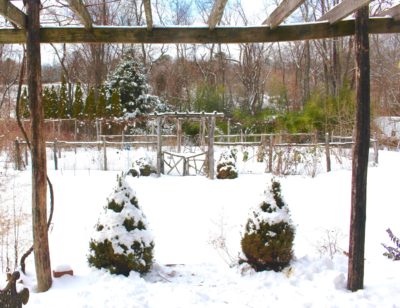
Spells of warmer weather and bright sunshine have eroded away some of the snow, mostly taking the fluffy, white lines and dots that rested atop fences and their fenceposts. The ground, as I write, is still pretty much covered in a white blanket. While I’m enjoying the wintry scene, I can forget about about the few odd jobs still left to do that are patiently waiting beneath the the snow.

